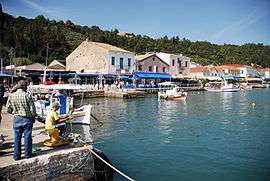Katakolo
| Katakolo Κατάκολο | |
|---|---|
|
Promenade of Katakolo | |
 Katakolo | |
| Coordinates: 37°39′N 21°19′E / 37.650°N 21.317°ECoordinates: 37°39′N 21°19′E / 37.650°N 21.317°E | |
| Country | Greece |
| Administrative region | West Greece |
| Regional unit | Elis |
| Municipality | Pyrgos |
| Municipal unit | Pyrgos |
| Community[1] | |
| • Population | 513 (2011) |
| Time zone | EET (UTC+2) |
| • Summer (DST) | EEST (UTC+3) |
Katakolo (Greek: Κατάκολο) is a seaside town in the municipality of Pyrgos in western Elis, Greece. It is situated on a headland overlooking the Ionian Sea and separating the Gulf of Kyparissia from the rest of the Ionian. It is 11 km west of downtown Pyrgos. The small village of Agios Andreas, which in ancient times was the natural harbour for Ancient Olympia, lies northwest of Katakolo. A railway connects Katakolo with Pyrgos and Olympia.[2]
History
In the Middle Ages, Katakolo was the site of the fortress of Pontikon or Pontikokastro (Ποντικόν, Ποντικόκαστρο), which the Frankish rulers of the Principality of Achaea called Beauvoir or Belveder.[3] The fortress was built by the Byzantines and taken over by the Franks ca. 1205.[4]
Visitor attractions
The port of Katakolo is a popular stop for cruise ships, offering an opportunity for passengers to visit the site of Olympia. Low hills with forests surround Katakolo. Visitors here have the opportunity to visit the ancient port of Olympia, the sunken ancient city of Pheia. Ancient Pheia was on the other side of the mountain of Ichthys, now Agios Andreas, within walking distance of Katakolo port. The lighthouse of Katakolo was built in 1865. One of the most important sites of Katakolo is the Museum of Ancient Greek Technology.
The remains of the medieval Pontikokastro/Beauvoir castle still stand on a hilltop northeast of the modern port, but the castle is mostly ruined and its original appearance can only be surmised.[5]
Historical population
| Year | Population of Katakolo |
|---|---|
| 1991 | 594 |
| 2001 | 601 |
| 2011 | 513 |
People
- Pavlos Haikalis (1949 -) actor and member of parliament
- Yiannis Latsis (1910–2003) shipping tycoon
- Magic Mizrahi (1983-....) John Panierakis, Sanga Carlos Cantounis & John Kampiotis, music producers in the Israeli psytrance industry.
Gallery
 The main street
The main street View of harbour
View of harbour Cruise ships at the harbour
Cruise ships at the harbour Cruise ship Costa Fortuna in Katakolo, April 2009
Cruise ship Costa Fortuna in Katakolo, April 2009
See also
References
Sources
- Bon, Antoine (1969). La Morée franque. Recherches historiques, topographiques et archéologiques sur la principauté d’Achaïe (in French). Paris: De Boccard.
External links
| Wikimedia Commons has media related to Katakolo. |
